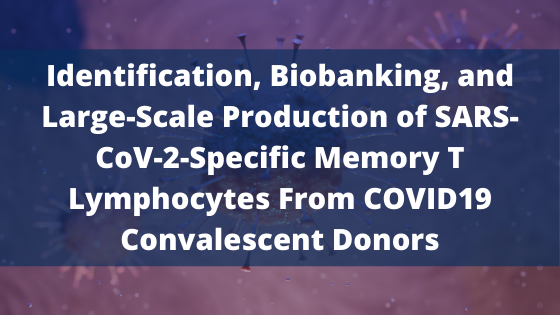The new SARS-CoV-2 emerged as a worldwide pandemic in late 2019. It is causing an infectious disease known as COVID-19, with a wide and diverse range of symptoms. In most infected patients, the virus causes mild symptoms including fever and cough. In some cases, however, the virus causes life-threatening disease. The symptoms include pneumonia, dyspnea, and a hyperinflammatory process that includes cytokine storms and systemic immune thrombosis. Patients suffering from these symptoms require hospitalization and intensive treatment.
Various measures were implemented to contain the first wave of the pandemic, although thousands of patients died. Far from disappearing, the SARS-CoV-2 pandemic has begun its second wave, thereby dimming the hopes for its complete eradication. The development of vaccines has vigorously pursued to generate active immunity through immunization, but there is uncertainty as to the duration of the antibody-mediated immune response to COVID-19. Effective treatments are needed that can reduce symptoms severity and hospital stays and increase survival.

So far, the only treatment for COVID-19 is supportive. The role of adaptive immunity in COVID-19 and the protective immunity conferred by T cells is still being characterized. The presence of memory T cells specific for another SARS coronavirus was found up to 11 years post-infection. This immunological memory creates a more rapid and robust secondary immune response to reinfections.
Memory T cells do appear when T cells recognize a pathogen presented by their local antigen-presenting cells. These T cells activate, proliferate, and differentiate into effector cells secreting compounds to control the infection. Once the pathogen has been cleared, most of the antigen-specific T cells disappear, and a pool of heterogeneous long-lived memory T cells persists. This population of memory T cells, defined as CD45RA– or CD45RO+, is maintained over time conferring rapid and long-term immune protection against subsequent reinfections.
In this study, authors Ferreras et al. report the presence of a SARS-CoV-2 specific T-cell population within CD45RA– memory T cells from the blood of convalescent donors that can be easily, effectively, and rapidly isolated by CD45RA depletion. These specific SARS-CoV-2 CD45RA– memory T cells may be able to clear virally infected cells and confer T-cell immunity for subsequent reinfections. The study included 6 COVID-19 convalescent donors and 2 healthy controls. The eligibility criteria included an age of 21–65 years, a history of COVID-19 with a documented positive RT-PCR test for SARS-CoV-2. At the time of this study, all donors tested negative for SARS-CoV-2. The study enrolled two healthy donors who had not been exposed to COVID-19 patients and tested negative at the time of enrollment.
The authors reported the presence of a SARS-CoV-2-specific T-cell population within the CD45RA– memory T cells of blood from convalescent donors. These cells can be easily, effectively, and rapidly isolated following a donor selection strategy based on IFN-γ expression after exposure with SARS-CoV-2-specific peptides and HLA antigen expression, thereby obtaining clinical-grade CD45RA– memory T cells from the blood of convalescent donors. These cells can be biobanked, thawed, and employed as a treatment for moderate to severe cases of COVID-19. These so-called “living drugs” retain the memory against SARS-CoV-2 and other pathogens the donors have encountered.
Click here to read more.
